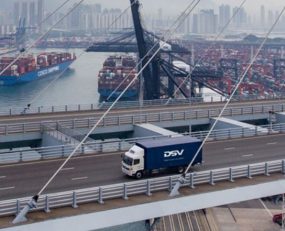
DSV Panalpina had a successful first full year following the merger in the second half of 2019, with the integration now behind the company. Q4 results show the company is smaller than the sum of its previous parts, but that it cuts a more efficient organisation in terms of margins.
Revenues for the year of DKK*115,932m were generated, up 22.4%. Amid cost cutting measures (including reducing staff numbers by 5% in April), and new synergies from the Panalpina integration, the company generated EBIT before special items of DKK 9,520m, up 43.1%. This is an improvement on pre-COVID guidance of DKK 8,200m – DKK 8,700m.
In Forwarding, it is clear how the merger has changed DSV and Panalpina. The final quarter of 2020 was the first with the full impact of the Panalpina acquisition seen in comparative figures and it shows the new company is smaller than the individual entities of DSV and Panalpina combined. The loss of a major customer, scaling back of Panalpina’s perishable business and discontinuation of other activities were noted as reasons for air volumes falling a staggering 26% year-on-year in Q4, well below market performance. In Sea, volumes fell 14%, also below the market.
However, revenues in Forwarding for the year totalled DKK 73,689m, up 44.1%, driven by the inclusion of Panalpina results for the other three quarters and sky-high freight rates. The company also utilised Panalpina’s air charter network to good effect as vast swathes of bellyhold capacity was grounded. EBIT before special items was DKK 7,026m, up 55.9%. This gave the Forwarding division an operating margin of 9.5% for the year, up from 8.8% the year before. The company hopes to repeat this efficiency next year through further profitable expansion, although it is also aiming for above market growth (perhaps to recover some lost volumes) which may mean it has to compromise on margin.
In Road, revenues fell by 3.9% for the year. Panalpina’s inclusion was accretive to this, but according to guidance from its Q1 report, the inclusion was worth around 4% of DSV Panalpina’s full year 2020 revenues. In Q4 growth was reported at 1.7%, marking a solid turnaround after a difficult year in the road freight sector. The company noted strong domestic distribution activity but commented that international transport had not fully recovered from the difficulties seen at the start of the pandemic. It was in Northern Europe, areas where it is strongest domestically, where better performances were noted. EBIT before special items was up 11.1% due to cost-saving initiatives and lower rates from external hauliers. Operating margin improved to a healthy 4.6% (2019: 4.0%).
The Solutions business’ revenues grew to DKK 14,608m from DKK 14,390m in the year before. Again, it should be noted that DSV previously anticipated Panalpina adding DKK 2,000m in revenues.
However, the company had a strong Q4 showing relative to market performance with growth of 0.2% on a like-for-like basis. The company had seen growth in e-commerce, pharma, essential retail and DIY store sales, but automotive and capital goods have failed to recover. The company commented that e-commerce business had increased costs, but it saw an improvement in operating margin for the year (from 7.0% to 7.9%) due to a 14.6% improvement in EBIT before special items.
Now DSV appears has completed the integration of Panalpina (after also purchasing Prime Cargo and Globeflight) it could turn to further M&A. CEO Jens Bjørn Andersen commented that “M&A is carved in stone in the strategy document of DSV” and “In an ideal world we’d wait a little to digest Panalpina, but there is also a need to be opportunistic.”
Source: Transport Intelligence, February 11, 2020
Author: Andy Ralls
*DKK=$0.15/DKK=€0.13